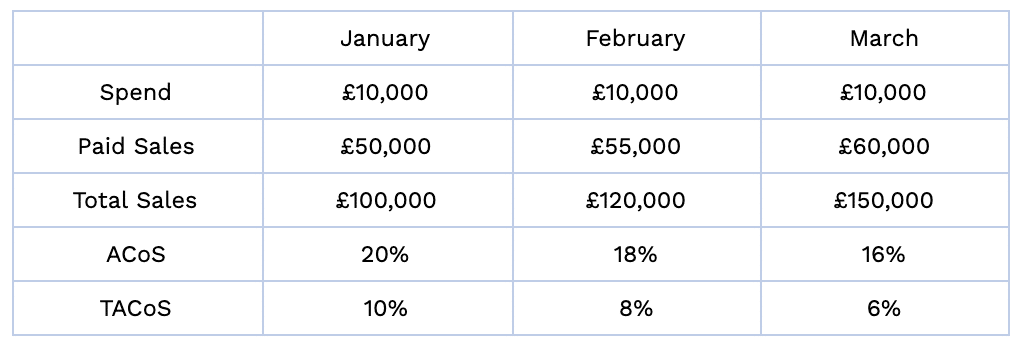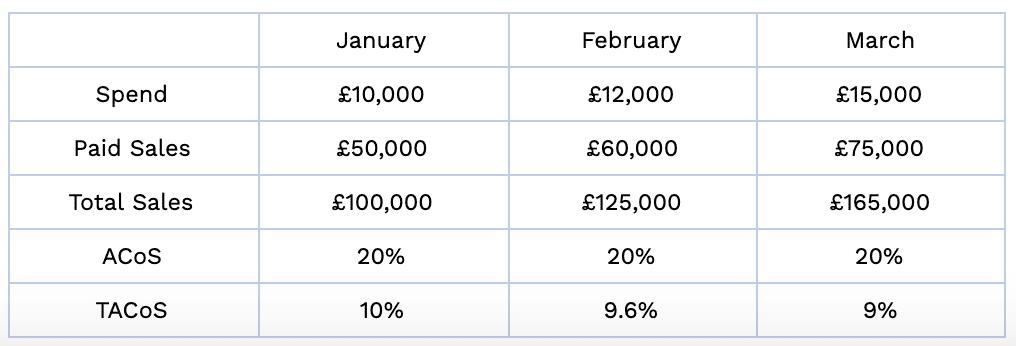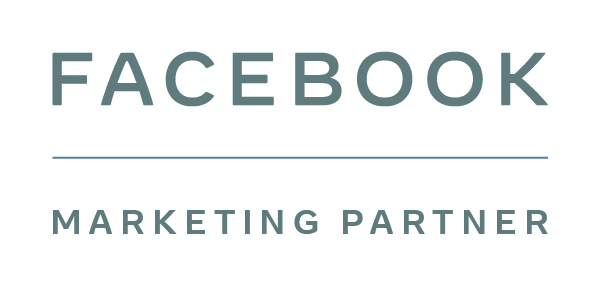If you’ve never used Amazon Advertising before, or only ever on a single account, it’s hard to know what the benchmarks are for success, or how much you should be investing.
This is true for any paid spend, but advertising on Amazon is new for many retailers and so it can be challenging to understand what a good ROI is. What does success on Amazon look like?
First, for the uninitiated, here’s an explanation of some key metrics in Amazon Advertising.
What is ACoS?
ACoS (Advertising Cost of Sale) is calculated by dividing ad spend by ad revenue. For example, a spend of £100 generating £1000 would give you an ACoS of 10% (pronounced A-Coz, in case you have to use it in conversation). This is just the reverse formula for those who normally calculate Return On Ad Spend (ROAS) by dividing revenue by spend.
What is TACoS:
TACoS (Total Advertising Cost of Sale) is calculated by dividing ad spend by total revenue (including organic). This isn’t a metric you’ll find in the interface. While it’s not an exact measure of advertising performance, it gives insight into how much you’re spending in proportion to the size of the account. It also gives an indicator of how reliant you are on paid advertising and how much impact your ads have on overall performance.
Starting out on Amazon
When starting out with Amazon Advertising, you probably won’t know what a good or bad ACoS looks like. Sure, you might be achieving a 10:1 return on Google Ads, but Amazon is a very different place. You can’t necessarily measure performance against the benchmarks from other platforms.
As a rule, you can expect your ACoS and TACoS to start pretty high when you launch your brand on Amazon initially. This is generally due to lower conversion rates, as your products will be yet to build up positive reviews and your content might be a little unpolished. You’ll also likely be bidding aggressively, knowingly paying over the odds, in order to drive as much traffic to your products as possible.
But what are high metrics?
It’s tempting to give the default digital marketing answer of ‘it depends’ (it does), But I’m going to attempt to provide more concrete guidelines.
What is a high ACoS?
- >50%: Extreme. You might accept this for a limited time when launching new products, it’s almost certainly not profitable.
- 30 – 50%: High. Potentially appropriate for aggressive growth depending on your margins.
- 15 – 30%: Medium. Somewhere in this range is usually the sweet spot for growing over time while running ads profitably.
- <15%: Low. You expect this from mature accounts with well established products, or from campaigns with narrow targeting. You can achieve this in broader campaigns with very low bids, but at the expense of traffic/sales volume.
What is a high TACoS?
When deciding on a TACoS target, you should consider what the margins are after COGS, and the various Amazon fees. You can then decide what portion of the remaining profit is reasonable to reinvest into growth via paid advertising.
TACoS differs from ACoS when it comes to setting guidelines because what’s high or low is dependent on how much of your revenue comes from ads, and what you’re trying to achieve. The best way to view TACoS is to consider both organic and paid as one conjoined effort.
Both organic and paid sales contribute to rank, and users are just as likely to leave reviews regardless of the source of the sale (typically 1 – 5% of customers leave a review). As long as you’re not exceeding the target, even unprofitable ads can be benefiting the account long term. You might tolerate a much higher ACoS, which could facilitate expanded or experimental targeting in aid of incremental growth rather than restricting it to only the tried and tested keywords.
If you’re using sponsored products specifically to build rank for certain keywords, that can sometimes get expensive. A restrictive ACoS target might result in having to back off, whereas in the context of TACoS it may actually be proving a strong source of organic growth.
Using TACoS, you don’t worry as much about the immediate return, because that ad spend is viewed as a longer term investment in growth.
Of course, every account should still have an ACoS target for day-to-day management. But it can be informed by a higher level TACoS goal that can also dictate your budget.
What should retailers aim for?
Over time, you should see your ACoS decreasing naturally as products become more established and you refine targeting. If growth is your aim, you actually shouldn’t let it. While a low ACoS is more profitable, if that means that your TACoS has decreased it could be a sign that you’re underfunding products and missing out on sales that could be helping develop your best sellers.
For example, let’s say you adhered to a rigid £1000 per month budget. Over time you optimise and this improves your ACoS. During this time, your organic performance is also improving.

These wouldn’t be bad results, but assuming your TACoS target is 10%, what would happen if you were to maintain a more aggressive strategy and increase spend as your total revenue grows?

The above is simplistic, but demonstrates that fixating on a better ACoS alone can lead to missed opportunities to the tune of thousands.
Using a TACoS target doesn’t mean making excuses to run with a very high ACoS. It’s about keeping your advertising investment in perspective, and often equates to giving your ads just a little more room to manoeuvre.
Healthy TACoS and profitable ACoS
On Amazon, keeping sales growing over time is a big part of ranking well. As Amazon Advertising develops and the number of paid placements increases, maintaining a healthy TACoS as well as a profitable ACoS will become crucial to attaining, and retaining best sellers status.
Selling (and advertising) on Amazon can be challenging and it can be difficult to understand where you need to prioritise your efforts. If you’re interested in how we could help you with your strategy, then get in touch.





